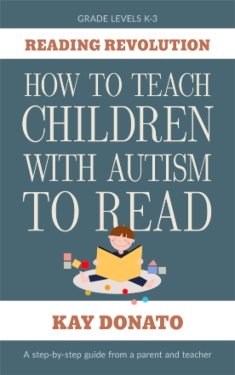| Back to Back Issues Page |
 |
|
Autism news: Sneak peek #3--Problems with learning to read and how to overcome them February 16, 2022 |
| Dear Friends, Last week I sent you a sneak peek from my upcoming book, Reading Revolution: How to Teach Children with Autism to Read, which included instructions for teaching alphabet sounds. Today, I want to show you portions of chapter 6 from the book that outline common pitfalls that many children with autism struggle with when learning to read and what can be done to help.
Excerpts from Chapter 6: Problems with Learning to Read and How to Overcome Them  Confusion over which way to read words and sentences
Confusion over which way to read words and sentences
Confusing left from right can cause problems in other ways. Mike also had difficulty learning where to begin reading words and sentences. Consider that this may be one reason some children read words backwards. But the problem may also be rooted in a confusion about whether to read the word from right to left or from left to right. If your child seems to have trouble remembering to read from left to right, a simple reminder can be helpful. You can try placing a reminder mark on the left side of the word or sentence. A pencil or chalk mark may be just what is needed and could save your child a lot of trouble, stress, and confusion. Once your child seems to have overcome that problem and appears to know right away to read from left to right, you can try to fade out the reminder to avoid dependence on it. Gradually lighten the pencil or chalk mark over time until it’s completely gone. Difficulty generalizing concepts Many of us have no problem learning a new skill in one setting and applying it to another situation. For example, when we were kids and we learned to count money in school during math class, most of us could have used our newfound skill to buy something at the store—we could have counted out the correct amount of money and given it to the cashier. But this transfer of newly learned skills to new situations doesn’t come as easily to children with autism. So, it may be hard for us to understand when our children struggle with this. Some parents may even be unaware of the problem. For example, your child may know letters and sounds just fine when you present them on flashcards but may have trouble if you write them down with a pencil and paper. Your child may even have a hard time reading from a book or may be able to read at home or school, but not in other settings. The answer to this problem is simple. Spend some time presenting the material one way to learn the material. Once your child knows the information one way, present the same information in at least two or three other ways, and even in various places. If you usually use flashcards, try occasionally switching to a chalkboard or to pencil and paper. And try practicing in other places besides the location where you usually conduct your lessons. This could be as easy as occasionally moving to the backyard for your lessons. As you teach your child to read words, you can continue to use whatever materials you’ve been using for your lessons. If your child likes magnets and they maintain interest in the lessons, then I would suggest continuing with magnets. Try to stick with one material until your child can read the words fairly well. Then switch to another one until your child can read the words using that material. You can then try a third material. Once able to read the words using a third material, I think you can be fairly confident that your child has generalized this skill. But the most crucial habit is to spend a few minutes each day reading a storybook. Enjoying a story is one of the best ways to generalize reading skills. You can take this even further by reading a newspaper or magazine with your child as well rather than reading books alone. ************ Next week, I plan to give you some tips from the book on how to turn story time with your child into an effective learning activity. Warm Regards, Kay Donato
http://www.aplusasd.com/
|
| Back to Back Issues Page |